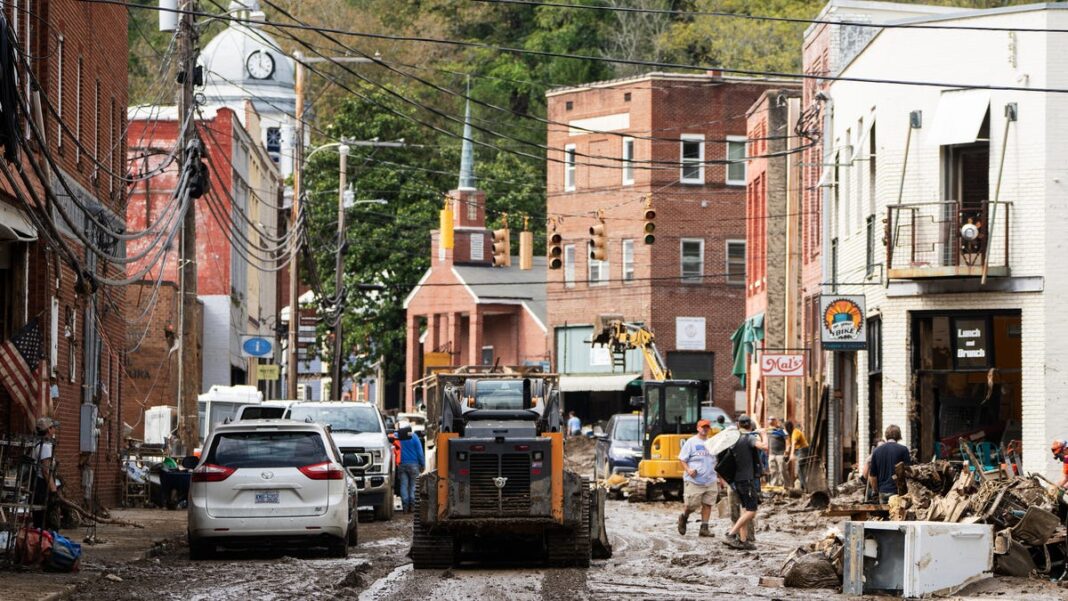Death toll from Hurricane Helene could increase; over 200 people unaccounted for in North Carolina: Updates from Friday
ASHEVILLE, N.C. — Search and rescue teams in western North Carolina continued their efforts on Friday to locate numerous missing individuals after Hurricane Helene unleashed unprecedented rain that devastated the Southeastern U.S., resulting in over 200 fatalities, obliterated towns, and leaving thousands without electricity or clean water.
The storm caused extensive damage to roads and bridges throughout the southern Appalachian region, isolating residents in already remote areas amid widespread power failures and loss of communication. Federal, state, and local officials intensified their efforts in the mountain suburbs around Asheville, making progress in clearing routes to deliver food, water, and other aid by air to those in need.
In addition, local volunteer groups in the mountainous areas of western North Carolina have joined the relief operations led by officials, providing assistance to trapped communities via foot, helicopter, and mule trains.
During a press conference on Thursday, authorities revealed that over 200 individuals are still reported missing in Buncombe County, which includes Asheville and its adjacent neighborhoods.
The death count rose over 200 on Thursday, according to an analysis by YSL News. This makes it the fourth deadliest hurricane to strike the U.S. mainland since 1950 and the most lethal since Hurricane Katrina in 2005. At least 72 deaths have been reported in Buncombe County.
Key Updates:
∎ Approximately 757,000 homes and businesses remained without power on Friday, down from a peak of over 4.5 million during the previous week, as reported by the YSL News outage tracker.
∎ Duke Energy announced that it aims to resolve most of the 600,000-plus outages in the Carolinas by Friday night.
Ongoing search effort for couple separated by massive flood
Five days after Tropical Storm Helene wreaked havoc in Western North Carolina, Anthony Vanoy sat by Buck Creek in rural McDowell County, watching as search and rescue teams sifted through a massive pile of debris looking for his friend, Julie le Roux.
Before rescuers arrived, Vanoy and a companion spent hours searching for le Roux. Among the debris, they discovered one of her paintings, depicting flowers.
On the morning of September 27, a “wall of water, rocks, and tree debris” inundated a neighbor’s house where le Roux and her fiancé John Norwood were taking shelter. The couple was swept away, and Norwood was found trapped nearly a four-minute walk from their home.
“I crawled around calling for her, but I just couldn’t find her,” Norwood recounted to ABC News earlier this week. As of Wednesday, le Roux had not been located.
Vanoy and Norwood are among many searching for missing loved ones after Helene’s impact. Officials reported receiving around 600 missing person reports earlier this week; however, that number has decreased as rescue crews penetrate deeper into isolated areas and restore communications.
– Jacob Biba, Asheville Citizen Times
Efforts to warn residents in advance of Helene
As Helene strengthened over the warm waters of the Gulf of Mexico, officials from the national weather service and local authorities in western North Carolina monitored the storm’s trajectory and intensity closely.
The situation appeared so alarming that by Wednesday, September 26, Buncombe County officials declared a local state of emergency for low-lying regions. While urgent alerts were posted on the county’s Facebook, no evacuation orders were issued. At the same time, the local National Weather Service office conducted daily meetings with government leaders to raise awareness about the flood risks associated with the storm.
On September 26, Buncombe County officials announced a virtual press conference, advising residents of the potential for “catastrophic” and “historic” flooding and for the first time, recommending that residents in flood-vulnerable areas consider evacuation. County manager Avril Pinder emphasized the gravity of the situation: “If you reside in a flood-prone area … you must take precautions now.”
On the morning of Friday, September 27, as reports of flooding began pouring in, Buncombe County issued a mandatory evacuation order that triggered alerts on phones through the Integrated Public Alert & Warning System, known as IPAWS, FEMA’s local emergency communication tool.
However, Clay Chaney, a meteorologist at the National Weather Service’s Weather Forecast Office in Greer, South Carolina, insisted that by then, it was already too late to evacuate. “When you receive a flash flood emergency alert, it’s far too late to evacuate. By that stage, your only option left is to move to higher ground,” he explained.
– Rick Jervis, Chris Kenning and Daniel Dassow, YSL News

